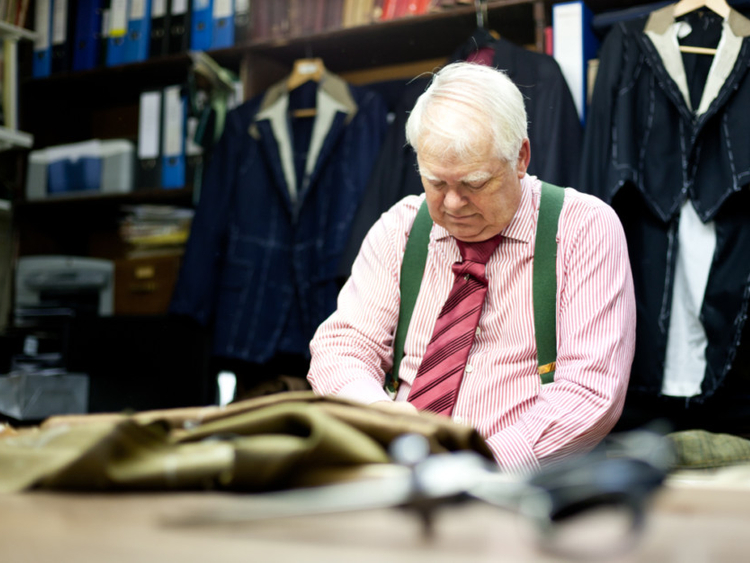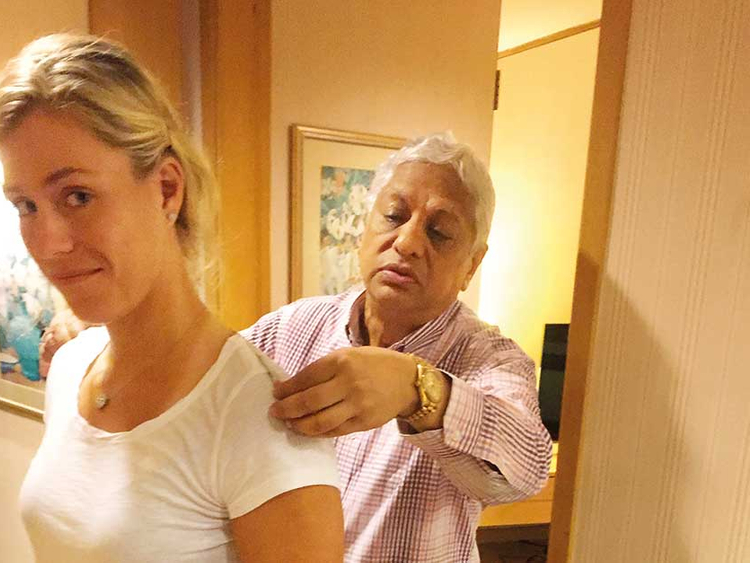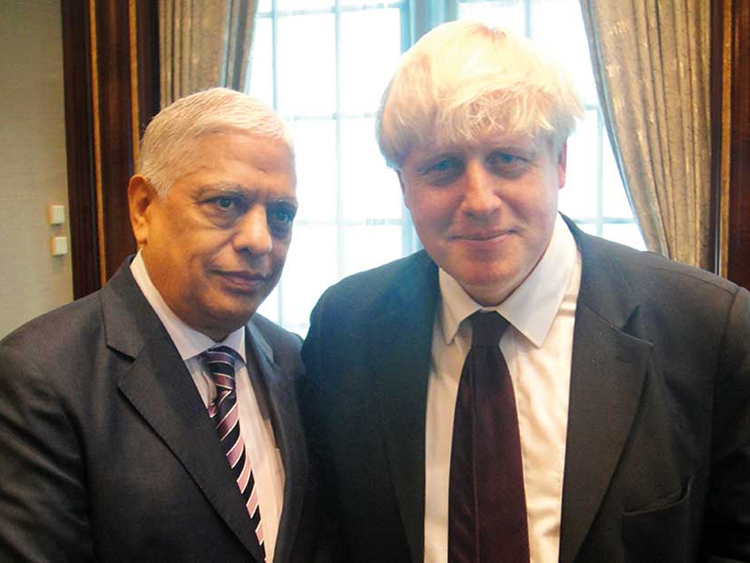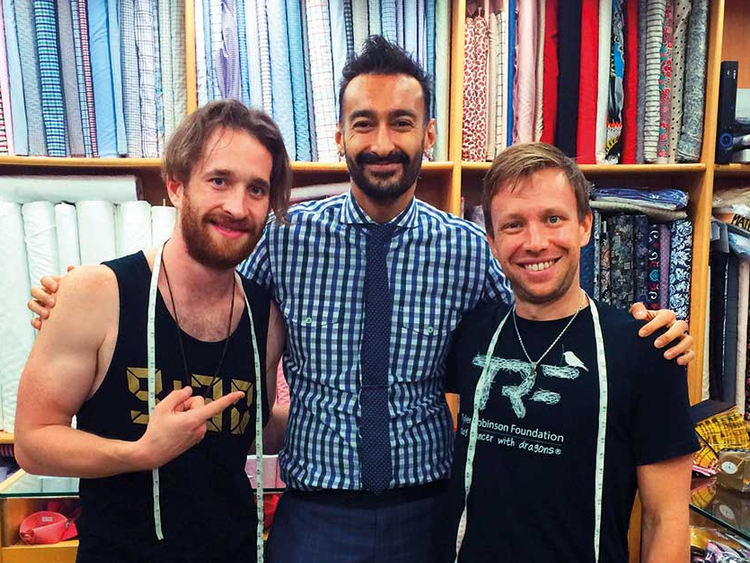
My grandfather was someone whom many would call a “brown sahib”. He would have his breakfast of toast, marmalade, poached eggs and coffee on finely crafted British plates, cups, toast racks, milk and sugar jugs. Most were the colour of clotted cream with a fine gold line at the edge. Even the bread knife that still cuts our bread better than any I have bought in India — with the manufacturer’s name elegantly carved on steel — was from Sheffield. Our cutlery cupboards hold the last standing elements of these sets. Some are chipped. But I can’t think of junking or losing these treasures.
Unfortunately, I did lose the best of his collection. They were either misplaced or stolen when we moved houses. It was a a wardrobe full of the most beautiful clothes. My grandfather had a rich and varied wardrobe ranging from the fine muslin dhotis and kurtas (crisped with starch) of Bengal to intricately tailored overcoats, jodhpur pants, and suits lined with silk. The latter he picked up on his journeys to Europe. Among them was a cream suit from London’s legendary Savile Row. Years later, when I came back to Kolkata and enquired about the clothes, I was greatly dismayed that they had been misplaced or stolen when our ancestral home had been broken down and built into a cubbyhole apartment block.
I was heartbroken. And the loss would keep coming back to haunt me. When I read yet another Wodehouse adventure involving men in spats, or watched episodes of Mad Men and Suits, I was reminded of them. Then Kingsmen: The Secret Service came on cinema screens, with its caddish spies fighting crime clothed in crisp threads from Savile Row.
When my son turned 16, and hankered for a suit (after watching Neal Caffrey in one too many episodes of White Collar), we did the rounds of major domo suit people like Raymonds as well as the bespoke outfits of Paris Tailors and J Mohammadally in Kolkata. It was interesting to find out that Paris Tailors was established in 1935. And that owner Ajit Singh had been to Savile Row to apprentice in the 1950s. He was featured in a 2012 New York Times article where the writer said that a suit he had got made here fit better than far more expensive suits he had ordered from Savile Row.
Handcrafted clothing
India has always had a tradition of tailors and handcrafted clothing. And there are several Indians who have made their mark on the world of bespoke suits. In 2016, creative director of Norton & Sons on Savile Row Patrick Grant, went around India conducting a series of tailoring workshops in Kolkata, Bengaluru, Jaipur, Patna and Lucknow. Conceptualised by Australian firm The Woolmark Co in association with Raymond, the workshops were held to educate tailors across the country through lectures, demonstrations, mock plays and tailoring guides.
A well-known bespoke outfit with Indian roots is Sam’s Tailor based in Hong Kong. It has dressed royalty (Queen Elizabeth II, Princes Phillip and Charles), presidents and prime ministers (Ronald Reagan, Margaret Thatcher, Tony Blair, Boris Johnson, George Bush Sr and Bill Clinton), and celebrities from every possible field (John McEnroe, Boris Becker, Michael Jackson, George Michael, Richard Gere, Kylie Minogue, David Bowie, Imagine Dragons, Kate Moss etc).
In 2016, Time magazine ran a feature on Prince and David Bowie and a shared Hong Kong tailor who mourned their loss. When The Amazing Race was shot in Hong Kong, the show and its contestants paid a visit to Sam’s Tailor in Tsim Sha Tsui.
Sam’s Tailor is run by father-son duo Manu and Roshan Melwani. Manu took over the business in 1957 from his father Sam. After India gained independence in 1947, Manu’s father Sam moved to Hong Kong to explore opportunities. He began by making military uniforms for the British. “It started to become well known when the Duke of Kent started shopping here in the 1970s,” says Roshan.
Manu has been given the Medal of Honour and Justice of the Peace (HK) and Belgium’s Knight of the Order of the Crown. Sam’s Tailor recently won a business award from the Hong Kong management association, and it has previously won an environmental award from the Hong Kong government. “These are unprecedented accomplishments by a standalone tailor shop,” says Roshan, who has a business degree from New York University and has worked in London.
Their material is sourced from Italy. They have 16 cutters and 43 tailors all from Shanghai or Hong Kong, while most of the Shanghai cutters are in their seventies and eighties and have been with them since 1959. “We have many guys who have worked for us for over 40 years — and a couple who have done so for over 50 years,” Roshan says
Then there is Savile Row’s Whitcomb and Shaftesbury, whose founders are brothers Mahesh and Suresh Ramakrishnan. Their customers include European royalty, business magnates, Hollywood celebrities, heads of state, rock and sports stars.
The brothers have an interesting story. They left India to study and then work abroad in the 1990s. Suresh is a Wharton alumnus, and worked with Goldman Sachs on IT risk-management algorithms. Mahesh was a systems integrator at a consulting firm. “Due to the client-focused nature of our jobs we were required to wear suits every day,” says Mahesh. “Every year we would go shopping for suits. Initially we started getting our suits made by local Indian tailors and then moved to the high-end department stores in New York before moving to designer brands.”
Quality and the fit
Suresh was based in London for long periods of time and used this opportunity to try out the bespoke tailors on London’s famed Savile Row.
“We found that this was when people were really impressed with the quality and the fit. Our science background in university sparked a natural curiosity about what made one suit different from the other and we started talking to people and taking apart our older suits to study the inside of the suits and the more we did things like this the more we got “hooked” into the wonderful world of bespoke craftsmanship,” says Mahesh. “Our friends and colleagues started noticing our suits and asked for introductions to our tailors and we started facilitating these meetings. During such meetings we found that there was a huge gap in the market for high quality advice on style and Whitcomb & Shaftesbury was born with a vision to provide the best tailoring with the best service and advice.”
Whitcomb & Shaftesbury’s Savile Row Bespoke line is made in London. Their other range, the more affordable Classic Bespoke, is cut in London and tailored in Chennai by craftsmen rigorously trained by Savile Row experts to match their standards. Among those experts is renowned head cutter John McCabe, who has been on Savile Row for over 40 years. And another legend is Bob Bigg, a master coat-maker who heads training of their India staff. The second product involves giving a livelihood option to Tamil Nadu’s tsunami victims.
“After the tsunami in South Asia, we were approached by the Children of the World charity to assist in a programme that they had started to support affected families through aid and the teaching of new vocational skills,” Manesh explains. “We joined them by helping teach and manage the hand tailoring aspect of the programme. Once that was successful we found that there was a large pool of highly skilled tailors but no real opportunities for them and we started our Chennai programme to offer them a continued opportunity to develop those skills and that gave us an option to offer a second line of suits to our customers — one that was cut in London but tailored in India).”
Over 4,000 people have gone through their training programme that starts with the very basics and goes all the way until they are trained in every aspects of bespoke tailoring up to the point where they are making a complete coat.
“The training is very comprehensive and managed by Bob Bigg, who is our master coatmaker from London and has been doing this for over 55 years,” Manesh says. “The people are trained in the same techniques and standards as our London coat and trouser makers.”
The programme is a multi-stage one, with each stage taking four months. After they have completed the programme, the top graduates are invited to join as apprentice coat makers with the company while others are offered assistance and placed into workshops and factories.
The brothers point to the rich tradition of craftsmanship that goes back centuries in India. “A lot of that has been lost due to the colonial destruction of looms and traditional crafts and, more recently, to the mass production of substandard but well marketed and cheap products,” Manesh says. “We have always found that the people we work with have the most beautiful and nimble hands and have a softness of touch that is unmatched in the western world save Italy. In fact I would say that the quality of the finishing in our suits that are made in India is better than what we find in London. We are proud that we are playing a small part in reviving that dormant skill and giving people around the world an opportunity to experience true Indian craftsmanship in the most western product — the suit.”
Anuradha Sengupta is a writer based in Mumbai, India.
80 hours of manual labour
Mahesh Ramakrishnan of Whitcomb & Shaftesbury reveals what goes into the making of a Savile Row suit:
A Savile Row suit is the absolute pinnacle of bespoke tailoring. There are tailors all over the world but they all look up to Savile Row as the standard bearer in this craft. Techniques that have been largely unchanged for the better part of 200 years are still employed and all the work is carried out by hand and iron. The hall mark of the Savile Row suit is the “floating” canvas that gives the garment a 3D structure and helps it mould around the wearers body. It is created using canvas and horsehair and silk thread and a heavy use of steam and iron to create a shape that wraps around the body.
A suit takes over 80 hours of manual labour to complete. It starts with a unique paper pattern that is created for every single customer by our master cutter John McCabe in London. John has been cutting in Savile Row for over 50 years and is widely regarded as the best cutter on the “Row”. The paper pattern is created taking into account every one of the customers unique measures (we take 30 measurements) and also postures, shoulder angles and a myriad of other notations that every customer has. The pattern is then transferred on to the cloth before being cut. This is then sent to India along with the trimmings (buttons, canvas, threads, linings) to be basted together before it returns for a fitting. After the fitting the entire garment is ripped down again before being recut and rebasted for a second fitting. This process is repeated until we perfect the fit and then finish the garment.
We only work with the finest mills in the world from the UK and Italy and only deal at the very top end of fabrics. Great care is taken to source the finest interlinings, buttons, threads and silks which are just as important as the fabric. This painstaking and elaborate process means that it typically takes between 8-12 weeks to make a first suit. Subsequent suits requiring fewer fittings and therefore tend to be quicker.

















